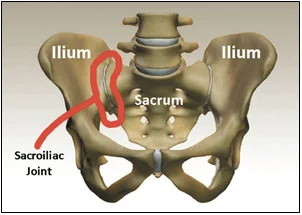If you have followed our first two articles, I am talking about lower back pain. In the first article, I discussed that your x-ray may not actually explain why your back is hurting. It’s a known fact that a very large percentage of people in America will show degenerative changes on their x-rays as they get older. So much so, these findings are actually considered “normal.” In the last article, I discussed the impact of muscle tightness on the spine. This week I’m going to discuss one of the hidden secrets that can give people fits with lower back pain. Believe it or not, most doctors don’t understand this part of your spine and how it contributes to low back pain.
Probably one of the most underappreciated parts of the spine that can cause lower back pain is the SI joint. The “SI” stands for the sacroiliac joint (pronounced “sack ro’ iliak”). The sacrum is the lowest part of the spine and sits between the ilium (pronounced “ill e um”).
The ilium is the upper portion of the pelvis. I often joke that the ilium is where a woman will put her hand when she is mad at a man. I use this as humor, but most people have seen this image at least once in their lives and understand from an anatomy standpoint, what I am talking about. All jokes aside, pelvic asymmetry is one of the most common pain generators when it comes to lower back pain. Unfortunately, pelvic position and SI joint dysfunction is misunderstood by most physicians and underappreciated as a source of back pain. Just ask your family doctor to explain a left on right backward sacral torsion next time you see them, and you will understand what I am referring to.
While chiropractors often use the word “alignment,” and that is a popular word here in the South, the physical therapy community calls this asymmetry “SI joint dysfunction.”
This dysfunction is easily treated if your healthcare provider knows how to address it. Despite what your chiropractor might have told you, you don’t need six months of treatment and a lifetime of maintenance for this to get better. Your pelvis can be put back in “alignment” on the first visit and most of the time, it will stay in position within a few weeks. Often, this will completely resolve your low back pain.
SI joint pain often shows up as pain in the dimple of your lower back. This dimple is just below your waist band and just off center to either side. SI joint dysfunction can present as localized pain just around the dimple but can also give you the feeling of sciatica with numbness and tingling going down your leg. Many times, this pain can also wrap around to the front of the hip where your thigh meets your pelvis.
It’s not clear what causes this dysfunction, but believe it or not, it is one of the easiest problems to treat. The key is first knowing how identify it, then how to “adjust” your
spine to move it into the right position, and finally how keep it in place. That’s where finding someone who knows how to identify and handle SI joint dysfunction is critical in your success and ability to get better. And by the way, our therapists are experts at treating this condition.
If you are having lower back pain, especially if you can identify the pain as described above and feel like you have “tried everything,” we invite you to call our office and schedule a FREE Complimentary Consultation to see if we can help. Even if you have already tried Physical Therapy or Chiropractic treatment in the past, our approach is so different, chances are you’ve never seen anything like it.
Call our office at 770-622-5344 to request an appointment. Be sure to catch my next article in two weeks where I will talk about disc bulges and herniations.
Johns Creek Physical Therapy 4060 Johns Creek Pkwy, Suite H Suwanee, GA 30024



